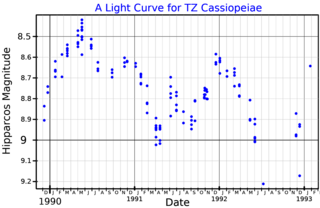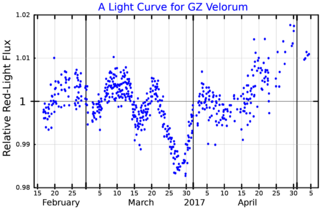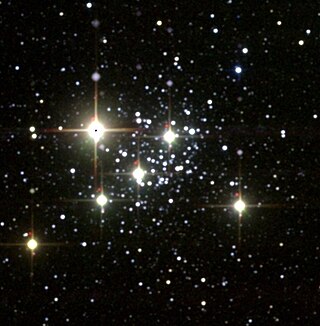Related Research Articles

ο Tauri, Latinized as Omicron Tauri, is a binary star system in the constellation Taurus, near the constellation border with Cetus. It has a yellow hue and is visible to the naked eye with an apparent visual magnitude of 3.61. It is approximately 191 light years from the Sun based on parallax, but is drifting closer with a radial velocity of −20 km/s. As the westernmost bright point of light in Taurus, this system has the Flamsteed designation 1 Tauri; Omicron Tauri is the Bayer designation.

Zeta Canis Minoris is a solitary, blue-white hued star in the equatorial constellation of Canis Minor. It is a dim star but visible to the naked eye with an apparent visual magnitude of 5.13. Based upon an annual parallax shift of 5.23 mas as seen from Earth, this star is located around 410 light years from the Sun. It is moving away from the Sun with a radial velocity of +32.3 km/s.
Upsilon2 Centauri is a binary star system in the southern constellation Centaurus. It is visible to the naked eye with an apparent visual magnitude of +4.33. Based upon an annual parallax shift of just 2.57 mas as seen from Earth, this star is located roughly 1,300 light years from the Sun. Relative to its neighbors, the system has a peculiar velocity of 39.2+8.8
−15.2 km/s and it may form a runaway star system.
28 Vulpeculae is a single star in the northern constellation of Vulpecula. It lies approximately 560 light years away and is visible to the naked eye as a faint, blue-white hued star with an apparent visual magnitude of 5.047. The star is moving closer to the Sun with a heliocentric radial velocity of −23 km/s, and may come as close as 198 light-years in 5.9 million years.
HD 223229 is a suspected variable star in the northern constellation of Andromeda. It is a double star consisting of a magnitude 6.11 primary and a magnitude 8.73 companion. The pair have an angular separation of 0.80″ along a position angle of 250°, as of 2009. The primary is a B-type subgiant star with a stellar classification of B3IV. It has an estimated 6.3 times the mass of the Sun, with an effective temperature of 17,900 K.
33 Vulpeculae is a single star located around 500 light-years away from the Sun in the northern constellation of Vulpecula. It is visible to the naked eye as a dim, orange-hued star with an apparent visual magnitude of 5.31. The object is drifting closer to the Earth with a heliocentric radial velocity of −25 km/s.
25 Vulpeculae is a single star in the northern constellation of Vulpecula, located roughly 1,170 light years away from the Sun. It is visible to the naked eye as a faint, blue-white hued star with an apparent visual magnitude of 5.50 This object is moving closer to the Earth with a heliocentric radial velocity of −11 km/s.

RT Carinae, also known as CD-58 3538, is a variable star in the Carina Nebula in the constellation Carina. It has a mean apparent magnitude of +8.55.

TZ Cassiopeiae(TZ Cas, HIP 117763, SAO 20912) is a variable star in the constellation Cassiopeia with an apparent magnitude of around +9 to +10. It is approximately 8,400 light-years away from Earth. The star is a red supergiant star with a spectral type of M3 and a temperature around 3,600 K.
63 Cygni is a single star in the northern constellation of Cygnus, located around 1,030 light years away from Sun. It is visible to the naked eye as an orange-hued star with an apparent visual magnitude of 4.56. 63 Cyg is moving closer to the Earth with a heliocentric radial velocity of −26 km/s.
HD 189276 is a single star in the northern constellation Cygnus, positioned near the northern constellation border with Draco. It has an orange hue and is faintly visible to the naked eye with an apparent visual magnitude of 4.98. The star is located at a distance of approximately 820 light years from the Sun based on parallax, and it has an absolute magnitude of −2.25. It is drifting further away with a radial velocity of +4 km/s. The star has a high peculiar velocity of 38.5+1.8
−2.2 km/s and thus is a probable runaway star.
2 Cygni is a blue-white hued star in the northern constellation of Cygnus, located a few degrees from Albireo. It is a probable astrometric binary; the visible component can be viewed with the naked eye, having an apparent visual magnitude of 4.976. Based upon an annual parallax shift of 3.6 mas, it is located roughly 910 light years from Earth. It has a peculiar velocity of 23 km/s and may be a runaway star system.

Theta Delphini, a name Latinized from θ Delphini, is a single star in the northern constellation of Delphinus. It has an apparent visual magnitude of about 5.7, meaning that it is just barely visible to the naked eye under excellent viewing conditions. The distance to this star is approximately 2,050 light years from the Sun based on parallax. It is drifting closer with a radial velocity of −15 km/s.

GZ Velorum is a single, orange-hued star in the southern constellation of Vela. It is a faint star but visible to the naked eye, having an apparent visual magnitude of 4.58. The star is located around 1,300 light years from Earth, as determined from its annual parallax shift of 2.4 mas. It is moving further away with a heliocentric radial velocity of +13 km/s.
26 Cygni is a single star in the northern constellation of Cygnus. It has the Bayer designation e Cygni, while 26 Cygni is the Flamsteed designation. This star is visible to the naked eye as a faint, yellow-hued point of light with an apparent visual magnitude of 5.12. It is located around 451 light-years (138 pc) distant from the Sun, based on parallax measurements. The radial velocity is close to negligible, being measured at −0.3 km/s.

RS Persei is a red supergiant variable star located in the Double Cluster in Perseus. The star's apparent magnitude varies from 7.82 to 10.0, meaning it is never visible to the naked eye.

DU Crucis is a red supergiant and slow irregular variable star in the open cluster NGC 4755, which is also known as the Kappa (κ) Crucis Cluster or Jewel Box Cluster.

NGC 7419 is an open cluster in the constellation Cepheus. It is heavily reddened and notable for containing five red supergiants, the highest number known in any cluster until the end of the 20th century, but probably no blue supergiants.

12 Pegasi is a K-type supergiant star in the constellation of Pegasus. It has a spectral type of K0Ib Hdel0.5, which indicates that it is a less luminous K-type supergiant with strong H-δ Balmer lines. The star has expanded to 81 times the radius of the Sun, and has an effective temperature of 4,185 K.

HD 27022, also known as HR 1327, is a star located in the northern circumpolar constellation Camelopardalis. The object has also been designated as 20 H. Camelopardalis, but is not commonly used in modern times. It has an apparent magnitude of 5.27, allowing it to be faintly visible to the naked eye. Based on parallax measurements from Gaia DR3, the star has been estimated to be 347 light years away. It appears to be approaching the Solar System, having a heliocentric radial velocity of −19.5 km/s.
References
- 1 2 3 4 5 6 7 8 9 10 Brown, A. G. A.; et al. (Gaia collaboration) (August 2018). "Gaia Data Release 2: Summary of the contents and survey properties". Astronomy & Astrophysics . 616. A1. arXiv: 1804.09365 . Bibcode: 2018A&A...616A...1G . doi: 10.1051/0004-6361/201833051 . Gaia DR2 record for this source at VizieR.
- 1 2 Fernie, J. D. (1983). "New UBVRI photometry for 900 supergiants". Astrophysical Journal Supplement Series. 52: 7. Bibcode:1983ApJS...52....7F. doi: 10.1086/190856 .
- 1 2 Keenan, Philip C.; McNeil, Raymond C. (1989). "The Perkins catalog of revised MK types for the cooler stars". Astrophysical Journal Supplement Series. 71: 245. Bibcode:1989ApJS...71..245K. doi:10.1086/191373.
- 1 2 3 4 Mermilliod, J. C.; et al. (2008). "Red giants in open clusters. XIV. Mean radial velocities for 1309 stars and 166 open clusters". Astronomy & Astrophysics. 485 (1): 303–314. Bibcode:2008A&A...485..303M. CiteSeerX 10.1.1.30.7545 . doi:10.1051/0004-6361:200809664.
- ↑ Anderson, E.; Francis, Ch. (2012). "XHIP: An extended hipparcos compilation". Astronomy Letters. 38 (5): 331. arXiv: 1108.4971 . Bibcode:2012AstL...38..331A. doi:10.1134/S1063773712050015. S2CID 119257644.
- 1 2 Hohle, M.M.; et al. (2010). "Masses and luminosities of O- and B-type stars and red supergiants". Astronomische Nachrichten. 331 (4): 349. arXiv: 1003.2335 . Bibcode:2010AN....331..349H. doi:10.1002/asna.200911355. S2CID 111387483.
- 1 2 3 4 Luck, R. Earle (March 1994). "Open Cluster Chemical Composition. I. Later Type Stars in Eight Clusters". Astrophysical Journal Supplement. 91: 309. Bibcode:1994ApJS...91..309L. doi:10.1086/191940.
- ↑ De Medeiros, J. R.; et al. (November 2000). "Rotation and lithium in single giant stars". Astronomy and Astrophysics. 363: 239–243. arXiv: astro-ph/0010273 . Bibcode:2000A&A...363..239D.
- 1 2 "19 Vulpeculae". SIMBAD . Centre de données astronomiques de Strasbourg . Retrieved 2018-11-18.